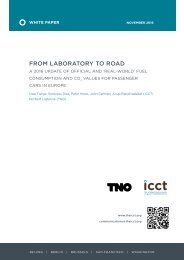Vol 55
Vol 55
Vol 55
- No tags were found...
Create successful ePaper yourself
Turn your PDF publications into a flip-book with our unique Google optimized e-Paper software.
20 Eileen M BowltIt may be difficult for us to assess the quality ofhis ideas, but his thoughts on the preservation ofancient buildings strike oddly on modern ears.Writing to Matthew Bloxam, author of Principlesof Gothic Architecture, in 1875, he asks 'is therelikely to be anything done about the rebuildingof the parish church, and are you disposed togive a plan for it? What say you to preservingthe tower and adding a Norman church to it?I should like to have the design by you, andwould in that case do what I could to organisea committee in London to raise subscriptions'.®The church in question can hardly be St Mary's,Northolt, as there was no tower there, only a bellturret added to the medieval chancel in the 16thcentury.HISTORIC BUILDINGSAt the first Council meeting there was a reportby the Rev Charles Boutell on the mutilatedcondition of some ancient statues at the westernend of Westminster Hall and the loss of othersduring cleaning.^ The chairman agreed to makerepresentations to Sir Charles Barry who wassupervising the slow rebuilding of the Palaceof Westminster after the 1834 fire. A letter wassent in January 1856. The Society had begun itsefforts at the preservation of ancient buildings.(The Society for the Protection of AncientBuildings was not founded until 1877.)The recording of London buildings wasbecoming essential in the 1850s as much of thelate medieval and Tudor built heritage was fastbeing torn down as sewers, railways, and wideroads were being planned and built. The RevThomas Hugo who lived in Bishopsgate Streetwas aware that many of the timber-framedbuildings in that corner of the City would soondisappear. He read a paper to the Society on 18February 1857 at the Gallery of British Artists,Suffolk Street, called an 'Itinerary of the Wardof Bishopsgate', describing in detail the housesin all the streets and alleys. His purpose was to'preserve the remembrance of edifices which thecrowbar and the shovel are daily annihilating'.'^It is not clear whether he had also led a grouparound the ward, but he had obviously workedout an itinerary for himself. When the paperappeared in Transactions}^ it was embellishedwith many engravings of the decorative andarchitectural details of such buildings as Sir PaulPindar's house (Fig 3), parts of which are now inthe V&A.Fig 3. A view of Sir Paul Pindar's house when it was aninn (From Walford's 'Old and Neiv London')MEETING CUM OUTINGS(LOCAL HISTORY)The early outings were in fact General Meetingsand Annual General Meetings held at variousvenues of historic interest. They were usuallyheld on weekdays and occupied most of theday, a reflection on the fairly leisured life styleof many members. The costs covering transportand either tea or dinner were in the order of 6shillings, again perhaps reflecting the social andfinancial standing of the members. Subscriptionshad begun at 10 shillings per annum, but hadrisen to one guinea, plus a 10 shillings entryfee. In January 1856 local Honorary Secretarieswere appointed for the principal towns in thecounty, perhaps with the object of arousing localinterest and facilitating such meetings. Mr PThompson offered to be local secretary for StokeNewington.The meetings were not for the faint heartedas they usually involved the reading of severallearned papers, followed by a sometimes stren-



